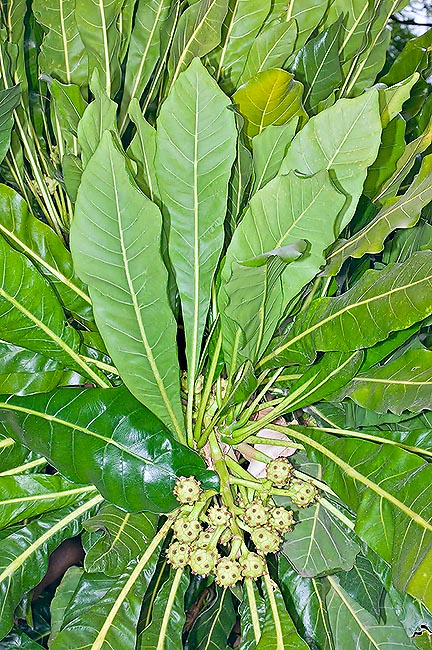Family : Araliaceae

Text © Pietro Puccio

English translation by Mario Beltramini

6 m tall, very decorative but little tilled. Medicinal properties © G. Mazza
The Meryta denhamii Seem. (1862) is native to the humid forests of New Caledonia.
The name of the genus is of uncertain origin, it is thought to be coming from the Greek “merytos” = glomerate, with reference to the disposition of the male flowers in the inflorescence; the species is honoured to the English admiral Henry Mangles Denham (1800-1887).
Common names: “pacific puka” (English); “meryta” (Italian); “merita” (Spanish).
Evergreen tree, tall up to about 6 m, with glossy dark green leaves, coriaceous, grouped in the terminal part of the branches, which has the phenomenon of the heterophylly (presence on the same plant of differently shaped leaves), in the young plants the leaves are linear-elliptic, long up to about 40 cm and 10 cm broad, in the adult ones, they are oblanceolate with undulated margins and can reach the length of 1,2 m and a breadth of 25 cm, on a 2-10 cm long petiole.
The plant is dioecious (each individual carries either only male or female flowers), with terminal inflorescences paniculate, long up to about 25 cm, with small greenish-yellow flowers grouped in globose umbrellas of 2-3 cm of diameter; the fruits are yellowish, globose, with a diameter up to 4 cm, and come from the fusion of 10-16 berries. It reproduces by seed and semi-woody cutting with bottom heat and confined space.
Not much cultivated plant in spite of its undoubted ornamental characteristics, it is cultivable in tropical, subtropical and marginally warm temperate zones, as it bears, when young, temperatures around -2°C for short time, some grade less when adult, but with damage to the aerial part; exposition both in full sun or partial shade, on soils preferably deep, draining, rich og organic substance, kept constantly humid during the vegetative period.
Recent studies have found in the plant the presence of bio-active compounds which can be of interest in several fields of medicine.
Synonyms: Aralia reticulata Linden ex B.S.Williams (1870); Meryta macrocarpa Baill. (1878); Meryta macrocephala Baill. (1878); Oreopanax reticulatus (Linden ex B.S.Williams) L.H.Bailey (1900); Meryta superba Borzí (1906); Strobilopanax macrocarpus (Baill.) R.Vig. (1906); Strobilopanax macrocephalus (Baill.) R.Vig. (1906).
→ To appreciate the biodiversity within the ARALIACEAE family please click here.
